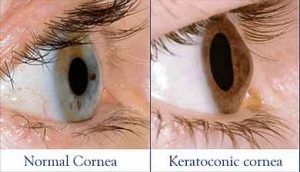Keratoconus is an uncommon condition in which the dome-shaped cornea (the clear front window of the eye) becomes thin and develops a cone-like bulge. As the condition progresses, the shape of the cornea is altered, which distorts vision. Usually, keratoconus affects both eyes, although symptoms and progression in each eye may differ.
Early symptoms include mild blurring of vision, increased sensitivity to light and glare, and mild eye irritation. Keratoconus usually begins in the teenage years. The rate of progression varies; It may progress slowly for 10 to 20 years, and then suddenly stop. As it progresses, the most common symptoms include: increased blurring, increased nearsightedness or astigmatism, frequent eyeglass prescription changes and inability to wear standard contact lenses.
The causes of keratoconus are not known. Since an estimated 10% of people with keratoconus have a family member with the condition, some researchers believe genetics may play a role.
Patients with keratoconus often require specialty contact lenses to achieve normal acuity. Custom designed soft or corneal gas-permeable contact lenses are usually prescribed for patients with mild or moderate keratoconus. Scleral contact lenses are prescribed to patients with severe keratoconus or when other specialty contact lens modalities fail.
Surgical treatment for select keratoconus patients include intrastromal ring segments or corneal cross linking. Patients who develop visual disabling scar tissue may need a corneal transplant to regain useful vision.
